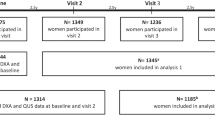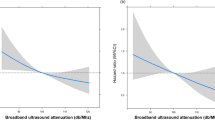Abstract
Background
Biochemical markers of bone turnover have been reported to predict fracture risk independent of bone mass in postmenopausal women. We investigated their use in predicting fractures in the frail elderly.
Methods
Cases were 151 low trauma fractures. For each case, a control was selected marched for sex, age, institution type and follow-up period. We measured two bone resorption markers (serum ICTP and serum CTX-I) and two bone formation markers (serum PINP and serum BAP). Quantitative Ultrasound (QUS) was measured in the calcaneus. Fractures were ascertained by x-ray reports.
Results
The mean age of subjects was 86.8 years (± 5.8 SD) and 86% were female. 76% had hypovitaminosis D (a serum 25 hydroxy vitamin D (25OHD) level < 39 nmol/L) and 81% had BUA < 67.4 dB/MHz (corresponding to a BMD T-score < −2.5). No significant differences in bone turnover markers were detected between fracture cases and their matched controls. In contrast, there was a significant difference between cases and controls for both broadband ultrasound attenuation (BUA) and velocity of sound (VOS) (both P < 0.05). These results remained the same after adjusting for weight, lower leg length and walking aids as well as the higher falls incidence in cases than controls (average 2.7 vs 0.9 falls respectively; P < 0.001) during the follow-up period.
Conclusion
In the frail elderly with vitamin D deficiency and high falls risk, calcaneal ultrasound but not markers of bone turnover were associated with fractures.
Similar content being viewed by others
References
Garnero P, Sornay-Rendu E, Chapuy MC, Delmas PD (1996) Increased bone turnover in late postmenopausal women is a major determinant of osteoporosis. J Bone Miner Res 11:337–349
Garnero P, Hausherr E, Chapuy MC, Marcelli C, Grandjean H, Muller C, Cormier C, Breart G, Meunier PJ, Delmas PD (1996) Markers of bone resorption predict hip fracture in elderly women: the EPIDOS Prospective Study. J Bone Miner Res 11:1531–1538
Garnero P, Sornay-Rendu E, Claustrat B, Delmas PD (2000) Biochemical markers of bone turnover, endogenous hormones and the risk of fractures in postmenopausal women: the OFELY study. J Bone Miner Res 15:1526–1536
Gerdhem P, Ivaska KK, Alatalo SL, Halleen JM, Hellman J, Isaksson A, Pettersson K, Vaananen HK, Akesson K, Obrant KJ (2004) Biochemical markers of bone metabolism and prediction of fracture in elderly women. J Bone Miner Res 19:386–393
Meier C, Nguyen TV, Center JR, Seibel MJ, Eisman JA (2005) Bone resorption and osteoporotic fractures in elderly men: the dubbo osteoporosis epidemiology study. J Bone Miner Res 20:579–587
Ross PD, Kress BC, Parson RE, Wasnich RD, Armour KA, Mizrahi IA (2000) Serum bone alkaline phosphatase and calcaneus bone density predict fractures: a prospective study. Osteoporos Int 11:76–82
Seibel MJ, Naganathan V, Barton I, Grauer A (2004) Relationship between pretreatment bone resorption and vertebral fracture incidence in postmenopausal osteoporotic women treated with risedronate. J Bone Miner Res 19:323–329
Van Daele PL, Seibel MJ, Burger H, Hofman A, Grobbee DE, Van Leeuwen JP, Birkenhager JC, Pols HA (1996) Case-control analysis of bone resorption markers, disability, and hip fracture risk: the Rotterdam study. BMJ 312:482–483
Sambrook PN, Chen JS, March LM, Cameron ID, Cumming RG, Lord SR, Zochling J, Sitoh YY, Lau TC, Schwarz J, Seibel MJ (2004) Serum parathyroid hormone predicts time to fall independent of vitamin D status in a frail elderly population. J Clin Endocrinol Metab 89:1572–1576
Zochling J, Sitoh YY, Lau TC, Cameron ID, Cumming RG, Lord SR, Schwarz J, Trube A, March LM, Sambrook PN (2002) Quantitative ultrasound of the calcaneus and falls risk in the institutionalized elderly: sex differences and relationship to vitamin D status. Osteoporos Int 13:882–887
Gibson MJ, Andres RO, Isaacs B, Radebaugh T, Worm-Petersen J (1987) The Prevention Of Falls In Later Life. A Report Of The Kellogg International Work Group on the Prevention of Falls by the Elderly. Dan Med Bull 34:1–24
Cockcroft DW, Gault MH (1976) Prediction of creatinine clearance from serum creatinine. Nephron 16:31–41
Zochling J, Nguyen TV, March LM, Sambrook PN (2004) Quantitative ultrasound measurements of bone: measurement error, discordance, and their effects on longitudinal studies. Osteoporos Int 15:619–624
Naganathan V, March L, Hunter D, Pocock NA, Markovey J, Sambrook PN (1999) Quantitative heel ultrasound as a predictor for osteoporosis. Med J Aust 171:297–300
Bauer DC, Gluer CC, Cauley JA, Vogt TM, Ensrud KE, Genant HK, Black DM (1997) Broadband ultrasound attenuation predicts fractures strongly and independently of densitometry in older women. A prospective study. Study of Osteoporotic Fractures Research Group. Arch Intern Med 157:629–634
Khaw KT, Reeve J, Luben R, Bingham S, Welch A, Wareham N, Oakes S, Day N (2004) Prediction of total and hip fracture risk in men and women by quantitative ultrasound of the calcaneus: EPIC-Norfolk prospective population study. Lancet 363:197–202
Dhesi JK, Bearne LM, Moniz C, Hurley MV, Jackson SH, Swift CG, Allain TJ (2002) Neuromuscular and psychomotor function in elderly subjects who fall and the relationship with vitamin D status. J Bone Miner Res 17:891–897
Flicker L, Mead K, MacInnis RJ, Nowson C, Scherer S, Stein MS, Thomasx J, Hopper JL, Wark JD (2003) Serum vitamin D and falls in older women in residential care in Australia. J Am Geriatr Soc 51:1533–1538
Mowe M, Haug E, Bohmer T (1999) Low serum calcidiol concentration in older adults with reduced muscular function. J Am Geriatr Soc 47:220–226
Janssen HC, Samson MM, Verhaar HJ (2002) Vitamin D deficiency, muscle function, and falls in elderly people. Am J Clin Nutr 75: 611–615
Pfeifer M, Begerow B, Minne HW (2002) Vitamin D and muscle function. Osteoporos Int 13:187–194
Bischoff HA, Stahelin HB, Urscheler N, Ehrsam R, Vonthein R, Perrig-Chiello P, Tyndall A, Theiler R (1999) Muscle strength in the elderly: its relation to vitamin D metabolites. Arch Phys Med Rehabil 80:54–58
Gloth FM III, Smith CE, Hollis BW, Tobin JD (1995) Functional improvement with vitamin D replenishment in a cohort of frail, vitamin D-deficient older people. J Am Geriatr Soc 43:1269–1271
Verhaar HJ, Samson MM, Jansen PA, de Vreede PL, Manten JW, Duursma SA (2000) Muscle strength, functional mobility and vitamin D in older women. Aging (Milano.) 12:455–460
Chen JS, Cameron ID, Cumming RG, Lord SR, March LM, Sambrook PN, Simpson JM, Seibel MJ (2006) Effect of age-related chronic immobility on markers of bone turnover. J Bone Miner Res 21:324–331
Sahota O, Mundey MK, San P, Godber IM, Lawson N, Hosking DJ (2004) The relationship between vitamin D and parathyroid hormone: calcium homeostasis, bone turnover, and bone mineral density in postmenopausal women with established osteoporosis. Bone 35:312–319
Acknowledgments
This study was supported by an Australian NHMRC grant, Arthritis Australia and the Osteoporosis Australia Research Fund.
Author information
Authors and Affiliations
Corresponding author
Rights and permissions
About this article
Cite this article
Chen, J.S., Seibel, M.J., Zochling, J. et al. Calcaneal Ultrasound but Not Bone Turnover Predicts Fractures in Vitamin D Deficient Frail Elderly at High Risk of Falls. Calcif Tissue Int 79, 37–42 (2006). https://doi.org/10.1007/s00223-005-0287-1
Received:
Accepted:
Published:
Issue Date:
DOI: https://doi.org/10.1007/s00223-005-0287-1




